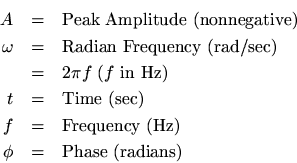NOTE: THIS DOCUMENT IS OBSOLETE, PLEASE CHECK THE NEW VERSION: "Mathematics of the Discrete Fourier Transform (DFT), with Audio Applications --- Second Edition", by Julius O. Smith III, W3K Publishing, 2007, ISBN 978-0-9745607-4-8. - Copyright © 2017-09-28 by Julius O. Smith III - Center for Computer Research in Music and Acoustics (CCRMA), Stanford University
<< Previous page TOC INDEX Next page >>
Sinusoids
A sinusoid is any function of time having the following form:
where all variables are real numbers, and
The term ''peak amplitude'' is often shortened to ''amplitude,'' e.g., ''the amplitude of the sound was measured to be 5 Pascals.'' Strictly speaking, however, the ''amplitude'' of a signal
is its instantaneous value
at any time
. The peak amplitude
satisfies
. The ''instantaneous magnitude'' or simply ''magnitude'' of a signal
is given by
, and the peak magnitude is the same thing as the peak amplitude.
Note that Hz is an abbreviation for Hertz which physically means ''cycles per second.'' You might also encounter the older (and clearer) notation ''c.p.s.'' for cycles per second.
Since
is periodic with period
, the phase
is indistinguishable from the phase
. As a result, we may restrict the range of
to any length
interval. When needed, we will choose
i.e.,. You may also encounter the convention
.
Subsections
